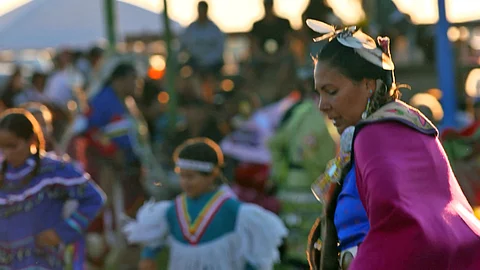

They stood facing each other, laughing the wide-toothy-smiled laugh that only women of a certain age have mastered. "Fiyna, fiyna!" my Baba Mary exclaimed. Her open palms tracing an invisible line around the head of the woman from Peguis First Nation. The woman lifted her clasped-hands from atop her belly and placed them on Baba's shoulders. "Pootiska, babushka!" And they laughed again, standing inside Rivard's General Store in Fisher Branch, Manitoba, tickled that they were in fact wearing matching kerchiefs—both headscarves boldly decorated with a profusion of red and pink roses against a sky-blue background.
It was the late 1960s, and as a girl tagging along on a shopping trip into town, it was my introduction to that fact that grandmothers, whether they be Ukrainian babas or Indigenous kokums, they were more similar than different.
Ukrainians came to Prairie Canada by the tens of thousands in the late 1800s and into the 20th century, anxious to flee political turmoil in their beloved country and enticed by the promise of free land from the Canadian government.
They largely settled in Manitoba, Saskatchewan and Alberta, homelands of Indigenous peoples including the Cree, Anishinaabe and Metis.
Friendships blossomed from shared experiences. Indigenous peoples showed newcomers how to fish and hunt in this vast land. Ukrainians, anxious to settle their farms, employed Indigenous workers. And the grandmothers, revered in both cultures, made sure song and spirituality, full bellies and beauty were maintained. Trades were common. The colourful kerchiefs that Ukrainians brought from the Old Country were no doubt on the table.
The headscarves are known as khustka in the Ukrainian language. It was rare to see a married Ukrainian woman without one in those days. The Cree kokums first called them pootishka, meaning 'she is wearing' and through time and repetition, they became known as babushkas. It's a term that has solidified itself in Prairie culture. Ukrainian-Canadians and even non-Ukrainians know exactly what they are. Utter the words, “Let me grab my babushka, it's windy outside” or “That's my Baba in the red babushka,” and everyone in these parts knows exactly what you mean. Indigenous cultures call them kokum scarves.
As a journalist in the late 1980s, I attended my first pow-wow. There, during the show-stopping Grand Entry, where dancers and elders dance a slow circle to open the gathering, kokum scarves were in no short supply. They were draped around the shoulders of some women. The vibrant kerchiefs covered gray hair, tidy knots under the chins of others. And among the dancers, scarves adorned their unique regalia, some sewn into necklines, others part of a wide skirt.
It was at the powwow that I also saw the intricate beadwork of Indigenous cultures in a new light. The tiny beads were worked together into patterns that echoed the designs on my Babas' babushka. Vibrant colours, bold patterns and a never-ending tumble of flowers sounded loud and clear in both cultures.
Babushkas and kokum scarves could easily be passed off as a relic of a romantic past between Ukrainians and Indigenous peoples. But they aren't. They are alive and well. Pop into Kalyna Ukrainian Book & Gift Shop or Cree-Ations & Artists Showcase and you'll find stacks of the neatly folded squares, ready for sale.
On a recent trip to Ukraine, kerchiefs remained part of everyday dress. In city markets, vendors of all ages wore them and sold them, flipping open the squares for potential buyers to inspect. During our stay with my cousins, Ihor and Maria, the conversation—in Ukrainian—turned to my husband, and Maria remarked, a bit in jest, that as a married woman, I really should be wearing a kerchief. She jumped up, ran to her dresser and returned with a blazing blue babushka with red roses which she expertly tied around my head, securing it in the back—a fashionable twist. "Fiyna, fiyna," she said.